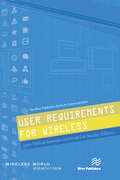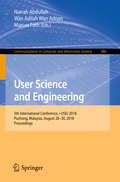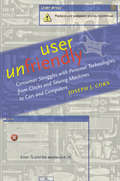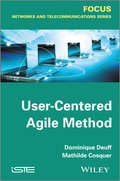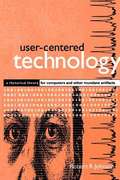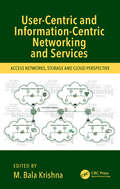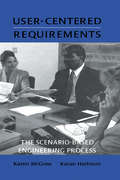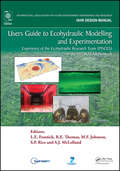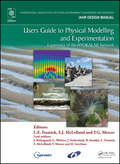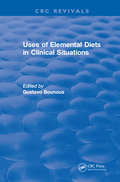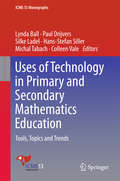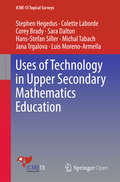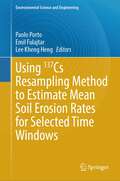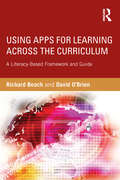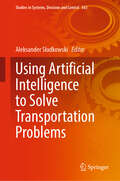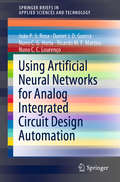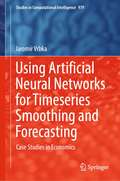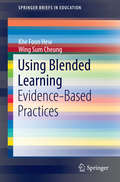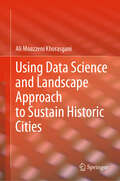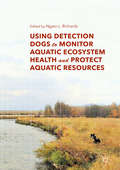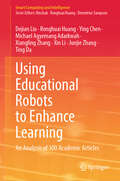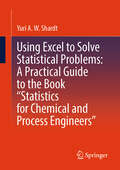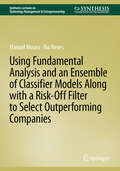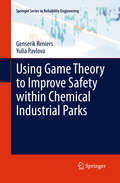- Table View
- List View
User Requirements for Wireless (River Publishers Series In Communications Ser.)
by Lene Tolstrup Sørensen Knud Erik SkoubyIn most IT system development processes, the identification or elicitation of user requirements is recognized as a key building block. In practice, the identification of user needs and wants is a challenge and inadequate or faulty identifications in this step of an IT system development can cause huge problems with the final product. The elicitation of user requirements as such changes according to age groups;, to gender,; to cultural settings,; and into time; and experience in the use of the system/software. User requirements, therefore, cannot be used between projects, IT systems, and different software. That makes the elicitation of user requirements an inherent part of any software development project and a resourceful activity as well. This book provides insights to the process of identifying user requirements and to different types by describing varying case studies in which technologies or software has been developed. A variety of user requirements are provided illustrating the effect of changing the targeted user group with respect to age,; to the context and the different technologies or software as well as to the difference in viewpoint on ways of involving users in the elicitation process. Cases and user requirement elements discussed in the book include: • User requirements elicitation processes for children, construction workers, and farmers• User requirements for personalized services of a broadcast company• Variations in user involvement• Practical elements of user involvement and requirements elicitation• Usable security requirements for design of privacy.
User Science and Engineering: 5th International Conference, i-USEr 2018, Puchong, Malaysia, August 28–30, 2018, Proceedings (Communications in Computer and Information Science #886)
by Marcus Foth Natrah Abdullah Wan Adilah Wan AdnanThis book constitutes the refereed proceedings of the 5th International Conference on User Science and Engineering, i-USEr 2018, held in Puchong, Malaysia, in August 2018. The 32 papers accepted for i-USEr 2018 were selected from 72 submissions with a thorough double-blind review process. The selected papers illustrate how HCI is inclusive and omnipresent within the domains of informatics, Internet of Things, Quality of Life, and others. They are organized in the following topical sections: design, UX and usability; HCI and underserved; technology and adoption; human centered computing; HCI and IT infrastructure; and HCI and analytics.
User Unfriendly: Consumer Struggles with Personal Technologies, from Clocks and Sewing Machines to Cars and Computers
by Joseph J. CornWe’ve all been there. Seduced by the sleek designs and smart capabilities of the newest gadgets, we end up stumped by their complicated set-up instructions and exasperating error messages. In this fascinating history, Joseph J. Corn maps two centuries of consumer frustration and struggle with personal technologies.Aggravation with the new machines people adopt and live with is as old as the industrial revolution. Clocks, sewing machines, cameras, lawn mowers, bicycles, electric lights, cars, and computers: all can empower and exhilarate, but they can also exact a form of servitude. Adopters puzzle over which type and model to buy and then how to operate the device, diagnose its troubles, and meet its insatiable appetite for accessories, replacement parts, or upgrades. It intrigues Corn that we put up with the frustrations our technology thrusts upon us, battling with the unfamiliar and climbing the steep learning curves. It is this ongoing struggle, more than the uses to which we ultimately put our machines, that animates this thought-provoking study.Having extensively researched owner’s manuals, computer user-group newsletters, and how-to literature, Corn brings a fresh, consumer-oriented approach to the history of technology. User Unfriendly will be valuable to historians of technology, students of American culture, and anyone interested in our modern dependence on machines and gadgets.
User-Centered Agile Method
by Mathilde Cosquer Dominique DeuffAgile development methods began to emerge around 20 years ago. However, it was not until the early 2000s that they began to be widely used in industry. This growth was often due to the advent of Internet services requiring faster cycles of development in order to heighten the rate at which an ever-greater number of functionalities were made available. In parallel, user-centered design (UCD) methods were also becoming more and more widely used: hence, user-centered design and agile methods were bound to cross paths, at least in the telecoms industry! During this period, in the field of telecommunications, the explosion in the number of connected terminals, Web applications, new use environments (particularly in a domestic setting), etc., meant it was crucial to gain a fuller understanding of users’ requirements and better evaluate the relevance and acceptance of services’ attempts to cater for these requirements. Thus the user-centered agile method, as proposed in this book, aims to mutually integrate two existing methods: user-centered design – as used by ergonomists – and the agile Scrum method – as used by developers. The user testing method is also covered. Analyzing work on this subject spanning the past 10 years, the authors also provide an assessment of the feedback on the user-centered agile method. The method described in this book has been based on all these sources. It is a framework relying on the logic introduced by Scrum, i.e. a framework based on project management. The method proposed is seen as an extension of Scrum which is “centered on humans” because of the integration of user-centered design and user-testing. Therefore the description of the user-centered agile method is based on the basics of the agile Scrum method and uses its terminology and elements. As well as descriptive elements of the user-centered agile method, practical examples of how to implement it are also provided. Contents 1. Introduction. 2. Intrioduction to the Methods Employed. 3. Sources for this Work. 4. Description of The User-Centered Agile Method. 5. Case Studies. About the Authors Dominique Deuff worked at the National Institute of Informatics in Japan for 2½ years before coming back to France in June 2006 and joining Orange Labs France Telecom as a developer in a Scrum team. In 2008, she graduated with a Master’s degree in ergonomics and has since then been applying her new skills to various projects at Orange Labs Lannion. Mathilde Cosquer joined Orange Labs as an ergonomist after completing her PhD on the question of transparency of technical devices from the user’s point of view. She has taken part in the design and evaluation of numerous innovating services, but over the past four years, she has been more particularly involved in projects of interpersonal communication services.
User-Centered Technology: A Rhetorical Theory for Computers and Other Mundane Artifacts
by Robert R. JohnsonPresents a theoretical model for examining technology through a user perspective. Begins with a historical overview of the problem of technology use through the lens of rhetoric theory, and defines central areas of user-centered theory, such as user knowledge, human-technology interaction, and technological determinism. Draws also from human factors engineering, history, philosophy, and sociology to discuss ideological presuppositions of technology design and technological determinism. Ideas are applied in academic and nonacademic contexts. Annotation copyrighted by Book News, Inc., Portland, OR
User-Centric Networking
by Alessandro Aldini Alessandro BoglioloThis work represents a milestone for the "ULOOP User-centric Wireless Local Loop" project funded by the EU IST Seventh Framework Programme. ULOOP is focused on the robust, secure, and autonomic deployment of user-centric wireless networks. Contributions by ULOOP partners as well as invited tutorials by international experts in the field. The expected impact is to increase awareness to user-centric networking in terms, e. g. , of business opportunities and quality of experience, and to present adequate technology to sustain the growth of user-friendly wireless architectures. Throughout the last 3 years, ULOOP has developed enabling technologies for user-centricity in wireless networks, with particular emphasis on social trust management, cooperation incentives, community building, mobility estimation, and resource management. This work will be of interest to researchers, policymakers, operators, vendors, and end-users interested in the current and future directions of user-centric access networks.
User-Centric and Information-Centric Networking and Services: Access Networks, Storage and Cloud Perspective
by M. Bala KrishnaUser-Centric Networks (UCN) and Information-Centric Networks (ICN) are new communication paradigms to increase the efficiency of content delivery and also content availability. In this new concept, the network infrastructure actively contributes to content caching and distribution. This book presents the basic concepts of UCN and ICN, describes the main architecture proposals for these networks, and discusses the main challenges to their development. The book also looks at the current challenges for this concept, including naming, routing and caching on the network-core elements, several aspects of content security, user privacy, and practical issues in implementing UCN and ICN.
User-centered Requirements: The Scenario-based Engineering Process
by Karen L. McGraw Karan HarbisonDeveloping today's complex systems requires more than just good software engineering solutions. Many are faced with complex systems projects, incomplete or inaccurate requirements, canceled projects, or cost overruns, and have their systems' users in revolt and demanding more. Others want to build user-centric systems, but fear managing the process. This book describes an approach that brings the engineering process together with human performance engineering and business process reengineering. The result is a manageable user-centered process for gathering, analyzing, and evaluating requirements that can vastly improve the success rate in the development of medium-to-large size systems and applications. Unlike some texts that are primarily conceptual, this volume provides guidelines, "how-to" information, and examples, enabling the reader to quickly apply the process and techniques to accomplish the following goals: * define high quality requirements, * enhance productive client involvement, * help clients maintain competitiveness, * ensure client buy-in and support throughout the process, * reduce missing functionality and corrections, and * improve user satisfaction with systems. This volume clearly details the role of user-centered requirements and knowledge acquisition within Scenario-Based Engineering Process (SEP) and identifies SEP products and artifacts. It assists project personnel in planning and managing effective requirements activities, including managing risks, avoiding common problems with requirements elicitation, organizing project participants and tools, and managing the logistics. Guidelines are provided for the following: selecting the right individual and group techniques to elicit scenarios and requirements from users; subject matter experts, or other shareholders; and ensuring engineers or analysts have the necessary skills.
Users Guide to Ecohydraulic Modelling and Experimentation: Experience of the Ecohydraulic Research Team (PISCES) of the HYDRALAB Network (IAHR Design Manual)
by L. E. Frostick S. J. McLelland R. E. Thomas M. F. Johnson S. P. RiceUsers Guide to Ecohydraulic Modelling and Experimentation has been compiled by the interdisciplinary team of expert ecologists, geomorphologists, sedimentologists, hydraulicists and engineers involved in HYDRALAB IV, the European Integrated Infrastructure Initiative on hydraulic experimentation which forms part of the European Community‘s Seventh F
Users Guide to Physical Modelling and Experimentation: Experience of the HYDRALAB Network (IAHR Design Manual)
by T. G. Mercer L. E. Frostick S. J. McLellandA Users Guide to Hydraulic Modelling and Experimentation provides a systematic, comprehensive summary of the progress made through HYDRALAB III . The book combines the expertise of many of the leading hydraulic experimentalists in Europe and identifies current best practice for carrying out state-of-the-art, modern laboratory investigations. In add
Uses of Elemental Diets in Clinical Situations
by G. BounousThe studies presented in this book demonstrate that a new concept in the management of carious intestinal disorders should be considered, namely, that common nutrients may protect or heal the mucosa by virtue of the particular form and mode in which they are delivered to the intestinal lumen and their availability to the mucosal cells. The substitution of intact protein in the formula by hydrolysate appears to me an important factor.
Uses of Technology in Primary and Secondary Mathematics Education: Tools, Topics And Trends (ICME-13 Monographs)
by Paul Drijvers Lynda Ball Hans-Stefan Siller Silke Ladel Michal Tabach Colleen ValeThis book provides international perspectives on the use of digital technologies in primary, lower secondary and upper secondary school mathematics. It gathers contributions by the members of three topic study groups from the 13th International Congress on Mathematical Education and covers a range of themes that will appeal to researchers and practitioners alike. The chapters include studies on technologies such as virtual manipulatives, apps, custom-built assessment tools, dynamic geometry, computer algebra systems and communication tools. Chiefly focusing on teaching and learning mathematics, the book also includes two chapters that address the evidence for technologies’ effects on school mathematics. The diverse technologies considered provide a broad overview of the potential that digital solutions hold in connection with teaching and learning. The chapters provide both a snapshot of the status quo of technologies in school mathematics, and outline how they might impact school mathematics ten to twenty years from now.
Uses of Technology in Upper Secondary Mathematics Education
by Hans-Stefan Siller Stephen Hegedus Colette Laborde Corey Brady Sara Dalton Michal Tabach Jana Trgalova Luis Moreno-ArmellaThis survey addresses the use of technology in upper secondary mathematics education from four points of view: theoretical analysis of epistemological and cognitive aspects of activity in new technology mediated learning environments, the changes brought by technology in the interactions between environment, students and teachers, the interrelations between mathematical activities and technology, skills and competencies that must be developed in teacher education. Research shows that the use of some technologies may deeply change the solving processes and contribute to impact the learning processes. The questions are which technologies to choose for which purposes, and how to integrate them, so as to maximize all students' agency. In particular the role of the teacher in classrooms and the content of teacher education programs are critical for taking full advantage of technology in teaching practice.
Using 137Cs Resampling Method to Estimate Mean Soil Erosion Rates for Selected Time Windows (Environmental Science and Engineering)
by Paolo Porto Emil Fulajtar Lee Kheng HengThis book provides guidelines for using a new approach of resampling the Cs-137 radionuclide tracer which is used to estimate soil erosion rates. The Cs-137 resampling approach will improve significantly the use of the Cs-137 method for assessment of soil erosion, because resampling the radionuclide repeatedly (at least two times, but more sampling campaigns are possible) allows to avoid several methodological difficulties associated with Cs-137 method, namely the problems with small-scale spatial heterogeneity, the question of representativeness of reference site, reference samples, and inappropriate time extent of evaluated period. All these methodological problems are very important for reliability and accuracy of erosion rates estimated by Cs-137 method. If using single sampling approach, the small-scale spatial heterogeneity can be overcome by high number of sampling points, but this is time and labour demanding solution increasing the expenses of the erosion research. The representativeness of reference site is evaluated usually on the basis of expert judgement and knowledge of land use history of studied area, but this approach is often uncertain because the expert judgement can be subjective and the data on land use history is often not sufficient. Further, in many areas an appropriate reference site is not available, what limits the territorial extent of using Cs-137 method. The resampling approach offers its second sampling to be done in a proximate vicinity of the same points sampled during the first sampling campaign. A great advantage is the possibility to decide how long time windows should be investigated. Choosing the time schedule of first and second sampling allows to shorten the time window and adjust it to the study objectives. This is a great improvement of the Cs-137 method, because the time period since the Cs-137 fallout is still growing and thus if using the single sampling approach the results refer to still longer and longer time window(since the Cs-137 fallout until the sampling time), and this period (recently ca 60 years assuming the maximum Cs-137 fallout in 1963) is too long to represent stable land use, because land uses are changing over the time and having the same land use over six decades is rather rare. The improvement of Cs-137 method achieved by resampling approach is significantly contributing to understanding the erosion dynamics and estimating its rates under changing environmental conditions (such as land uses, weather), and it will bring a significant benefit to soil conservation programmes, because Cs-137 method is indispensable for assessing the medium and long term soil erosion rates, and this information is among the basic inputs needed for planning and designing soil conservation measures.
Using Apps for Learning Across the Curriculum: A Literacy-Based Framework and Guide
by David O'Brien Richard BeachHow can apps be used to foster learning with literacy across the curriculum? This book offers both a theoretical framework for considering app affordances and practical ways to use apps to build students’ disciplinary literacies and to foster a wide range of literacy practices. Using Apps for Learning Across the Curriculum presents a wide range of different apps and also assesses their value features methods for and apps related to planning instruction and assessing student learning identifies favorite apps whose affordances are most likely to foster certain disciplinary literacies includes resources and apps for professional development provides examples of student learning in the classroom A website (www.usingipads.pbworks.com) with resources for teaching and further reading for each chapter, a link to a blog for continuing conversations about topics in the book (appsforlearningliteracies.com), and more enhance the usefulness of the book.
Using Artificial Intelligence to Solve Transportation Problems (Studies in Systems, Decision and Control #563)
by Aleksander SładkowskiThis book focuses on the role of Artificial Intelligence in solving transportation problems and presents papers from around the world on AI in transportation. Currently, the development of computer technology and software has led to what can be said to be the beginning of a fundamentally new stage in science and technology. This new level is called “Artificial Intelligence (AI).” AI can be used in any area of human activity. One of the broadest uses of AI comes from transportation, broadly understood. Obviously, it is impossible to present all the possibilities of AI in the field of design, production and operation of transport in one book. But the authors of this monothematic monograph tried to describe achievements in their areas. In particular, the use of AI allows you to save energy and fuel when using vehicles, improve the preparation and implementation of transport processes, simplify warehouse operations, analyze and modernize existing transport infrastructure. These and other aspects of the use of AI in the transport industry are discussed in the monograph by specialists from Greece, China, Poland and other countries. This book can be recommended for study by scientists and professionals. It can also be selected by teachers as additional material when preparing relevant courses. Moreover, it can also be recommended for any readers seriously interested in the transportation industry.
Using Artificial Neural Networks for Analog Integrated Circuit Design Automation (SpringerBriefs in Applied Sciences and Technology)
by Nuno C. Lourenço Ricardo M. Martins João P. Rosa Daniel J. Guerra Nuno C. HortaThis book addresses the automatic sizing and layout of analog integrated circuits (ICs) using deep learning (DL) and artificial neural networks (ANN). It explores an innovative approach to automatic circuit sizing where ANNs learn patterns from previously optimized design solutions. In opposition to classical optimization-based sizing strategies, where computational intelligence techniques are used to iterate over the map from devices’ sizes to circuits’ performances provided by design equations or circuit simulations, ANNs are shown to be capable of solving analog IC sizing as a direct map from specifications to the devices’ sizes. Two separate ANN architectures are proposed: a Regression-only model and a Classification and Regression model. The goal of the Regression-only model is to learn design patterns from the studied circuits, using circuit’s performances as input features and devices’ sizes as target outputs. This model can size a circuit given its specifications for a single topology. The Classification and Regression model has the same capabilities of the previous model, but it can also select the most appropriate circuit topology and its respective sizing given the target specification. The proposed methodology was implemented and tested on two analog circuit topologies.
Using Artificial Neural Networks for Timeseries Smoothing and Forecasting: Case Studies in Economics (Studies in Computational Intelligence #979)
by Jaromír VrbkaThe aim of this publication is to identify and apply suitable methods for analysing and predicting the time series of gold prices, together with acquainting the reader with the history and characteristics of the methods and with the time series issues in general. Both statistical and econometric methods, and especially artificial intelligence methods, are used in the case studies. The publication presents both traditional and innovative methods on the theoretical level, always accompanied by a case study, i.e. their specific use in practice. Furthermore, a comprehensive comparative analysis of the individual methods is provided. The book is intended for readers from the ranks of academic staff, students of universities of economics, but also the scientists and practitioners dealing with the time series prediction. From the point of view of practical application, it could provide useful information for speculators and traders on financial markets, especially the commodity markets.
Using Blended Learning
by Khe Foon Hew Wing Sum CheungThis book discusses evidence-based practices related to the use of blended learning in both K-12 and higher education settings. Specifically, this book features evidence-based practices in relation to the following five learning goals: (a) Fostering students' attitude change toward country, (b) Helping students' solve ill-structured design task problems, (c) Improving students' critical thinking in assessing sources of information, (d) Improving students' narrative and argumentative writing abilities and (e) Enhancing students' knowledge retention and understanding. To achieve this aim, the authors draw upon their own research studies as well as some other relevant studies to reveal the pedagogical approaches, the specific instructional/learning activities, the technologies utilized and the overall framework for developing blended learning experiences.
Using Data Science and Landscape Approach to Sustain Historic Cities
by Ali Moazzeni KhorasganiThis book comprehensively explores sustaining historic cities using a landscape approach and data science. The author offers valuable insights for professionals and enthusiasts interested in preserving and developing urban heritage through a data driven approach. Drawing on the synergy between landscape architecture and data science, the book delves into the intricate interplay between historical, cultural, and environmental factors in urban settings. Readers will understand how to navigate historic cities' complex challenges through case studies, research findings, and practical methodologies. The book equips readers with innovative strategies for preserving the authenticity of these cities while embracing sustainable development practices. By blending theory and real-world applications, this book is a comprehensive guide for creating thriving, resilient, and culturally rich urban environments.
Using Detection Dogs to Monitor Aquatic Ecosystem Health and Protect Aquatic Resources
by Ngaio L. RichardsThis book is about the varied range of emerging applications using specially trained detection dogs to monitor and protect aquatic ecosystems, animals, plants and related resources. Featuring contributions from those at the forefront of converging disciplines ranging from canine training, ecological and biological monitoring, water resource management, law enforcement, and eco-toxicology, it addresses everyone already immersed in these or related fields, and anyone seeking to gain a broader understanding of them. Chapters cover several common themes including monitoring presence/absence through biological and ecological surveys; maintaining and evaluating water quality; law enforcement and anti-poaching initiatives; public education, awareness and compliance; standards and best practices; optimal uses of dogs in relation to and in conjunction with other available tools and pragmatic considerations for selecting and working with dogs and handlers. The aim of the book is to stimulate new ideas, promote the sharing and dissemination of information and findings - and, ideally, to catalyze new and innovative partnerships, to strengthen the preservation and conservation of our aquatic heritage.
Using Educational Robots to Enhance Learning: An Analysis of 100 Academic Articles (Smart Computing and Intelligence)
by Xin Li Ying Chen Ronghuai Huang Dejian Liu Junjie Zhang Xiangling Zhang Michael Agyemang Adarkwah Ting DaThis book presents advances in the research of educational robotics and showcases how they can be used to facilitate learning. It summarizes popular and relevant terms and theories in educational robotics via analyzing one hundred influential journal articles in this field, to provide readers background knowledge on the subject matter. This book also guides readers in understanding how different types of robotics are utilized to promote learning among different types of students, in different contexts, and in different disciplines of study.
Using Excel to Solve Statistical Problems: A Practical Guide to the Book “Statistics for Chemical and Process Engineers”
by Yuri A.W. ShardtThis book provides a complete overview of how to use Excel to solve typical statistical problems in engineering. In addition to short sections on the required theory, the focus of the book is on detailed Excel examples for solving specific problems. Furthermore, solutions are provided for standard problems that can then be re-used and modified as necessary. End-of-chapter questions allow the reader to independently test the knowledge acquired.
Using Fundamental Analysis and an Ensemble of Classifier Models Along with a Risk-Off Filter to Select Outperforming Companies (Synthesis Lectures on Technology Management & Entrepreneurship)
by Rui Neves Manuel MouraThis book develops a quantitative stock market investment methodology using financial indicators that beats the benchmark of S&P500 index. To achieve this goal, an ensemble of machine learning models is meticulously constructed, incorporating four distinct algorithms: support vector machine, k-nearest neighbors, random forest, and logistic regression. These models all make use of financial ratios extracted from company financial statements for the purposes of predictive forecasting. The ensemble classifier is subject to a strict testing of precision which compares it to the performance of its constituent models separately. Rolling window and cross-validation tests are used in this evaluation in order to provide a comprehensive assessment framework. A risk-off filter is developed to limit risk during uncertain market periods, and consequently to improve the Sharpe ratio of the model. The risk adjusted performance of the final model, supported by the risk-off filter, achieves a Sharpe ratio of 1.63 which surpasses both the model’s performance without the filter that delivers Sharpe ratio of 1.41 and the one from the S&P500 index of 0.80. The substantial increase in risk-adjusted returns is accomplished by reducing the model’s volatility from an annual standard of deviation of 15.75% to 11.22%, which represents an almost 30% decrease in volatility.
Using Game Theory to Improve Safety within Chemical Industrial Parks
by Genserik Reniers Yulia PavlovaThough the game-theoretic approach has been vastly studied and utilized in relation to economics of industrial organizations, it has hardly been used to tackle safety management in multi-plant chemical industrial settings. Using Game Theory for Improving Safety within Chemical Industrial Parks presents an in-depth discussion of game-theoretic modeling which may be applied to improve cross-company prevention and -safety management in a chemical industrial park. By systematically analyzing game-theoretic models and approaches in relation to managing safety in chemical industrial parks, Using Game Theory for Improving Safety within Chemical Industrial Parks explores the ways game theory can predict the outcome of complex strategic investment decision making processes involving several adjacent chemical plants. A number of game-theoretic decision models are discussed to provide strategic tools for decision-making situations. Offering clear and straightforward explanations of methodologies, Using Game Theory for Improving Safety within Chemical Industrial Parks provides managers and management teams with approaches to asses situations and to improve strategic safety- and prevention arrangements.
